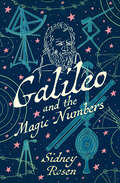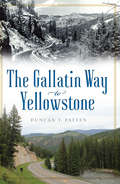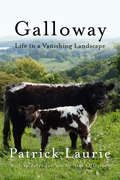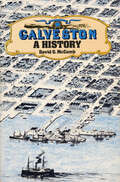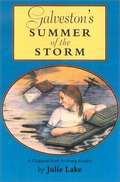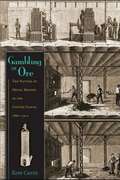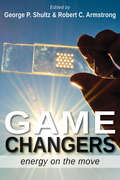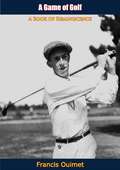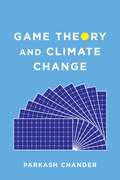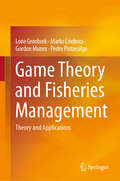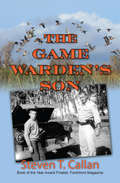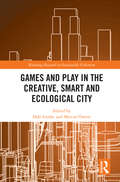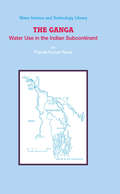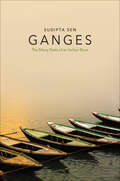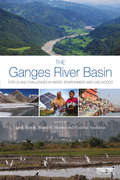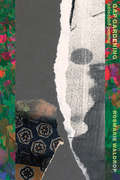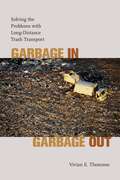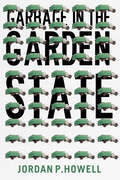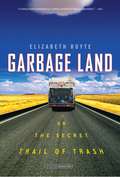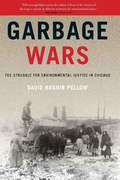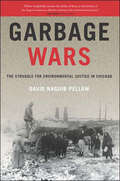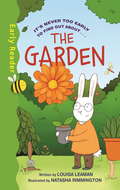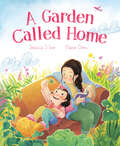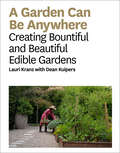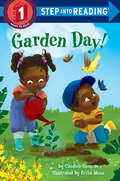- Table View
- List View
Galileo and the Magic Numbers
by Sidney RosenThis &“enjoyable&” biography of the brilliant astronomer will intrigue young people who are &“bored with the textbook approach to science&” (The New York Times Book Review). Sixteenth century Italy produced Galileo, a genius who marked the world with his studies and hypotheses about mathematical, physical, and astronomical truths. His father, musician Vincenzio Galilei said, &“Truth is not found behind a man&’s reputation. Truth appears only when the answers to questions are searched out by a free mind. This is not the easy path in life but it is the most rewarding.&” Galileo challenged divine law and the physics of Aristotle, and questioned everything in search of truths. And it was through this quest for truth that he was able to establish a structure for modern science.
The Gallatin Way to Yellowstone (Transportation)
by Duncan T. PattenThe Gallatin Way, a picturesque route heading south through the canyon to the west gate of Yellowstone, boasts a history covering more than a century of exploration, homesteading and development. Early pioneers and adventurers endured a rugged and unforgiving terrain where today's travelers speed along a modern highway. One might expect to see dramatic shifts, yet little change is evident in some areas, while others teem with contemporary luxuries. Pairing historic and modern photography of the same locations, Duncan T. Patten retraces the marvel of this iconic thoroughfare.
Galloway: Life In a Vanishing Landscape
by Patrick LaurieOn the land of his ancestors in Scotland, a young farmer struggles to find a balance between farming, the conservation of wild, and human culture as he establishes a herd of heritage cattle.Galloway, an ancient region in an obscure corner of Scotland, has a proud and unique heritage based on hardy cattle and wide moors. But as the twentieth century progressed, the people of Galloway deserted the land and the moors are transforming into a vast commercial forest. Desperate to connect with his native land, Patrick Laurie plunges into work on his family farm. Investing in the oldest and most traditional breeds of Galloway cattle, he begins to discover how cows—and the special care that this breed requires—once shaped people, places, and nature in this remote and half-hidden place. As the cattle begin to dictate the pattern of his life, Laurie stumbles upon another loss; the new forests have driven the catastrophic decline of the much-loved curlew, a bird that features strongly in Galloway's consciousness. The links between people, cattle, and wild birds become a central theme as Laurie begins to face the reality of life in a vanishing landscape. Exploring the delicate balance between farming and conservation while recounting an extraordinarily powerful personal story, Galloway delves into the relationship between people and places under pressure in the modern world.
Galveston: A History (Fred Rider Cotten Popular History Ser. #15)
by David G. MccombOn the Gulf edge of Texas between land and sea stands Galveston Island. Shaped continually by wind and water, it is one of earth's ongoing creations time is forever new. Here, on the shoreline, embraced by the waves, a person can still feel the heartbeat of nature. And yet, for all the idyllic possibilities, Galveston's history has been anything but tranquil. Across Galveston's sands have walked Indians, pirates, revolutionaries, the richest men of nineteenth-century Texas, soldiers, sailors, bootleggers, gamblers, prostitutes, physicians, entertainers, engineers, and preservationists. Major events in the island's past include hurricanes, yellow fever, smuggling, vice, the Civil War, the building of a medical school and port, raids by the Texas Rangers, and, always, the struggle to live in a precarious location. Galveston: A History is at the forefront of a trend in writing urban biographies emphasizing technology as the dynamic force in urban development. David McComb explores this often contradictory relationship between technology and the city, and provides a guide to both Galveston history and the dynamics of urban development.
Galveston's Summer of the Storm
by Julie LakeA fourteen-year-old girl from Austin spends the summer of 1900 at her grandmother's home in Galveston and is caught in the Great Hurricane of September 8, 1900.
Gambling on Ore: The Nature of Metal Mining in the United States, 1860-1910
by Kent CurtisGambling on Ore examines the development of the western mining industry from the tumultuous and violent Gold Rush to the elevation of large-scale copper mining in the early twentieth century, using Montana as representative of mining developments in the broader US mining west. Employing abundant new historical evidence in key primary and secondary sources, Curtis tells the story of the inescapable relationship of mining to nature in the modern world as the United States moved from a primarily agricultural society to a mining nation in the second half of the nineteenth century.In Montana, legal issues and politics--such as unexpected consequences of federal mining law and the electrification of the United States--further complicated the mining industry's already complex relationship to geology, while government policy, legal frameworks, dominant understandings of nature, and the exigencies of profit and production drove the industry in momentous and surprising directions. Despite its many uncertainties, mining became an important part of American culture and daily life. Gambling on Ore unpacks the tangled relationships between mining and the natural world that gave material possibility to the age of electricity. Metal mining has had a profound influence on the human ecology and the social relationships of North America through the twentieth century and throughout the world after World War II. Understanding how we forged these relationships is central to understanding the environmental history of the United States after 1850.
Game Changers: Energy on the Move
by Edited by George Shultz and Robert ArmstrongIt is becoming increasingly obvious that the United States needs reliable and inexpensive energy to propel our economy and protect our national security interests. Game Changers presents five research and development efforts from American universities that offer a cheaper, cleaner, and more secure national energy system. Drawing from the efforts of the MIT Energy Initiative (MITEI) and other leading university research centers, the book describes some of the energy innovations that will transform our future: natural gas from shales, solar photovoltaics, grid-scale electricity storage, electric cars, and LED lighting. For each of these innovations, the authors detail what is available today, what is near at hand, and what is on the horizon. In addition, they show how extreme energy reliability and performance demands put the United States military at the leading edge of driving energy innovations, and survey potentially game-changing energy technologies currently being put into use by the U.S. Army, Navy, Marine Corps, and Air Force, on base and in forward deployment. The more choices our laboratories put on the table, the less constrained we are in using them to reach the things we really care about—health, family, business, culture, faith, and delight. This is what game changers are ultimately about.
A Game of Golf: A Book of Reminiscence (The\sportstown Ser.)
by Francis OuimetFrancis Ouimet (1893-1967) was an unknown twenty-year-old amateur when he upset famed British golfers Harry Vardon and Ted Ray to win the 1913 U.S. Open. That spectacular victory at The Country Club (TCC) made him America’s first golf hero, drew new fans to the sport, and forever altered the image of golf as a stuffy, rich man’s game dominated by British and Scottish players.In this engaging memoir, first published in 1932, Ouimet reminisces about his life in golf and gives sage advice on playing the game. He vividly chronicles the boyhood he spent at his modest home across the street from The Country Club in Brookline, Massachusetts. With charm and wit he recalls how he scavenged for golf balls and clubs, learned to play on a homemade, three-hole course in his backyard, and sneaked onto The Country Club’s fairways to practice in the early morning hours. He recounts his caddying years, starting at age nine, the early amateur competitions, and the momentous 1913 U.S. Open tournament on his neighborhood course.Legendary is the story of Ouimet and his caddy, Eddie Lowery. Ouimet refused an experienced TCC member’s offer to carry his clubs during the 1913 playoff in favor of the ten-year-old boy.Ouimet’s illustrious amateur career journeys across the fairways of Hoylake, St. Andrews, Garden City, and Pebble Beach, and concludes with his victory in the 1931 U.S. National Amateur at Beverly Hills in Chicago.Brimming with exciting matches and great players such as Bobby Jones and Walter Hagen, these humble reminiscences of the working-class kid who changed the game of golf will inspire golf enthusiasts and general readers alike.
Game Theory and Climate Change
by Parkash ChanderDespite the growing consensus on the need for action to counteract climate change, complex economic and political forces have so far prevented international actors from making much headway toward resolving the problem. Most approaches to climate change are based in economics and environmental science; in this book, Parkash Chander argues that we can make further progress on the climate change impasse by considering a third approach—game theory.Chander shows that a game-theoretic approach, which offers insight into the nature of interactions between sovereign countries behaving strategically and the kinds of outcomes such interactions produce, can illuminate how best to achieve international agreements in support of climate-change mitigation strategies. Game Theory and Climate Change develops a conceptual framework with which to analyze climate change as a strategic or dynamic game, bringing together cooperative and noncooperative game theory and providing practical analyses of international negotiations. Chander offers economic and game-theoretic interpretations of both the Kyoto Protocol and the Paris Agreement and argues that the Paris Agreement may succeed where the Kyoto Protocol failed. Finally, Chander discusses the policy recommendations his framework generates, including a global agreement to support development of cleaner technologies on a global scale.
Game Theory and Fisheries Management: Theory and Applications
by Lone Grønbæk Marko Lindroos Gordon Munro Pedro PintassilgoThis book is the first to present in a systematic manner the application of game theory to fisheries management at both international and national levels. Strategic interaction among fishers and nations exploiting fishery resources is an inescapable fact of life. This has long been recognized at the international level, and is becoming increasingly recognized at the national/regional level. It follows, therefore, that, in order to be able to analyse effectively the management of these resources, the theory of strategic interaction ̶ game theory ̶ must be brought to bear. In this book the step-by-step development of the game theory is accompanied by numerous applications to the real world of fisheries management policy. As such, it is designed to appeal to policy makers and stakeholders, as well as to graduate students in Economics.
The Game Warden's Son
by Steven T. CallanA game warden’s “dynamic and authoritative” memoir of protecting the wild, named Best Outdoor Book of 2016 by the Outdoor Writers Association of California (New York Daily News). Retired game warden Steven T. Callan’s love of nature and passion for protecting wildlife took root long before the adventures he describes in his acclaimed memoir, Badges, Bears, and Eagles. In this follow up, he intertwines more than a half-century of adventures and investigations with stories of his relationship with his father. After an idyllic boyhood spent riding on patrol with his father in the canyons and beaches of California, Steven himself became a game warden in the early 1970s, joining the “desert rats” who patrolled the counties along the Colorado River. With wry humor, Callan tells how he and fellow officers outwitted perpetrators—most of them crafty, some of them hilariously foolish—who poached deer, lobsters, and abalone, baited bears, shot wild ducks to supply restaurants, and killed songbirds for epicurean dinner tables. Their cases took them across the Channel Islands, through the back alleys of San Francisco, into the Sierras, and along California’s pristine North Coast—all to protect California’s natural resources for future generations. “Callan’s writing is dynamic and authoritative, with an episodic structure that will keep experts and novice readers turning the pages” (New York Daily News).
Games and Play in the Creative, Smart and Ecological City (Routledge Research in Sustainable Urbanism)
by Dale Leorke Marcus OwensThis book explores what games and play can tell us about contemporary processes of urbanization and examines how the dynamics of gaming can help us understand the interurban competition that underpins the entrepreneurialism of the smart and creative city. Game and Play in the Creative, Smart and Ecological City is a collection of chapters written by an interdisciplinary group of scholars from game studies, media studies, play studies, architecture, landscape architecture and urban planning. It situates the historical evolution of play and games in the urban landscape and outlines the scope of the various ways games and play contribute to the city’s economy, cultural life and environmental concerns. In connecting games and play more concretely to urban discourses and design strategies, this book urges scholars to consider their growing contribution to three overarching sets of discourses that dominate urban planning and policy today: the creative and cultural economies of cities; the smart and playable city; and ecological cities. This interdisciplinary work will be of great interest to students and scholars of game studies, play studies, landscape architecture (and allied design fields), urban geography, and art history.
The Ganga
by Pranab Kumar ParuaThe geo-hydro-morphometry of the river Ganges has a history of long and wide variations as the river is continuously fed by the high Himalayas hill ranges, the highest in the world. The river is categorized as an international one, passing through several independent countries. The major flow of the river used to flow through the branch river, Bhagirathi-Hooghly on the banks of which both city and port of Calcutta (now renamed Kolkata) are situated. However, due to massive tectonic and morphological changes, the flow through the branch river has gradually decreased resulting in enormous damages to the port and the city. After more than a century of investigations on the probable causes of deterioration and its remedies, a barrage across the river had been constructed near a place called Farakka in the Murshidabad district of West Bengal, India for diversion of a part of lean season flow (40,000 cu secs) from the parent river to the branch river for the resuscitation of the branch river and revitalization of the port of Calcutta. The turmoil started since the construction of barrage between 1965-1975 and the major neighbouring countries, India and Bangladesh, were locked in the dispute over sharing the water of the parent river. After several rounds of discussions at different levels between the two countries, short-term agreements were signed two times, one in 1977 and the other in 1985, and finally one long term Treaty was signed in 1996 between the two countries in an atmosphere of peaceful co-existence. Audience: The book will be of interest to researchers and scientists, professionals and policymakers in water resources management and environmental science, conservation policy and development research.
Ganges: The Many Pasts of an Indian River
by Sudipta SenA sweeping, interdisciplinary history of the world’s third-largest river, a potent symbol across South Asia and the Hindu diaspora Originating in the Himalayas and flowing into the Bay of Bengal, the Ganges is India’s most important and sacred river. In this unprecedented work, historian Sudipta Sen tells the story of the Ganges, from the communities that arose on its banks to the merchants that navigated its waters, and the way it came to occupy center stage in the history and culture of the subcontinent. Sen begins his chronicle in prehistoric India, tracing the river’s first settlers, its myths of origin in the Hindu tradition, and its significance during the ascendancy of popular Buddhism. In the following centuries, Indian empires, Central Asian regimes, European merchants, the British Empire, and the Indian nation-state all shaped the identity and ecology of the river. Weaving together geography, environmental politics, and religious history, Sen offers in this lavishly illustrated volume a remarkable portrait of one of the world’s largest and most densely populated river basins.
The Ganges River Basin: Status and Challenges in Water, Environment and Livelihoods (Earthscan Series on Major River Basins of the World)
by Luna Bharati Bharat R. Sharma Vladimir SmakhtinThe Ganges is one of the most complex yet fascinating river systems in the world. The basin is characterized by a high degree of heterogeneity from climatic, hydrological, geomorphological, cultural, environmental and socio-economic perspectives. More than 500 million people are directly or indirectly dependent upon the Ganges River Basin, which spans China, Nepal, India and Bangladesh. While there are many books covering one aspect of the Ganges, ranging from hydrology to cultural significance, this book is unique in presenting a comprehensive inter-disciplinary overview of the key issues and challenges facing the region. Contributors from the three main riparian nations assess the status and trends of water resources, including the Himalayas, groundwater, pollution, floods, drought and climate change. They describe livelihood systems in the basin, and the social, economic, geopolitical and institutional constraints, including transboundary disputes, to achieving productive, sustainable and equitable water access. Management of the main water-use sectors and their inter-linkages are reviewed, as well as the sustainability and trade-offs in conservation of natural systems and resource development such as for hydropower or agriculture.
Gap Gardening: Selected Poems
by Rosmarie WaldropAn essential edition of a major avant-garde poet: “Waldrop compels us to seek out new superlatives” (Ben Lerner, Jacket) Rosmarie Waldrop says Gap Gardening “spans forty years of exploring the language I breathe and move in and that continues to condition me even while I try to contribute to it. It tracks my turn from verse to prose poems, to focusing on the sentence and its boundaries, my increasing reliance on collage and source texts as a way of engaging with other voices, of being in dialogue.” Gap Gardening also traces Waldrop’s growing sense of writing as an exploration of what happens in between. Between words, sentences, people, cultures. Between fragment and flow, thinking and feeling, mind and body. For the first time, we have a complete and clear view of the work of a great and inquiring, brave and indispensable poet.
Garbage In, Garbage Out: Solving the Problems with Long-distance Trash Transport
by Vivian E. ThomsonYour garbage is going places you'd never imagine. What used to be sent to the local dump now may move hundreds of miles by truck and barge to its final resting place. Virtually all forms of pollution migrate, subjected to natural forces such as wind and water currents. The movement of garbage, however, is under human control. Its patterns of migration reveal much about power sharing among state, local, and national institutions, about the Constitution's protection of trash transport as a commercial activity, and about competing notions of social fairness. In Garbage In, Garbage Out, Vivian Thomson looks at Virginia's status as the second-largest importer of trash in the United States and uses it as a touchstone for exploring the many controversies around trash generation and disposal.Political conflicts over waste management have been felt at all levels of government. Local governments who want to manage their own trash have fought other local governments hosting huge landfills that depend on trash generated hundreds of miles away. State governments have tried to avoid becoming the dumping grounds for cities hundreds of miles away. The constitutional questions raised in these battles have kept interstate trash transport on Congress's agenda since the early 1990s. Whether the resulting legislative proposals actually address our most critical garbage-related problems, however, remains in question.Thomson sheds much-needed light on these problems. Within the context of increased interstate trash transport and the trend toward privatization of waste management, she examines the garbage issue from a number of perspectives--including the links between environmental justice and trash management, a critical evaluation of the theoretical and empirical relationship between economic growth and environmental improvement, and highlighting the ways in which waste management practices in the US differ from those in the European Union and Japan. Thomson then provides specific, substantive recommendations for our own policymakers.Everything eventually becomes trash. As we explore the long, often surprising, routes our garbage takes, we begin to understand that it is something more than a mere nuisance that regularly "disappears" from our curbside. Rather, trash generation and management reflect patterns of consumption, political choices over whether garbage is primarily pollution or commerce, the social distribution of environmental risk, and how our daily lives compare with those of our counterparts in other industrialized nations.
Garbage in the Garden State (CERES: Rutgers Studies in History)
by Jordan P. HowellGarbage in the Garden State is the only book to examine the history of waste management in New Jersey. The state has played a pioneering role in the overall trajectory of waste management in the US. Howell's book is unique in the way that it places the contemporary challenges of waste management into their proper historical context – for instance, why does the system for recycling seem to work so poorly? Why do we have so many landfills in New Jersey, but also simultaneously not enough landfills or incinerators? Howell acknowledges that New Jersey is sometimes imagined, particularly by non-New Jerseyans, as a giant garbage dump for New York and Philadelphia. But every place has had to struggle with the challenges of waste management. New Jersey's trash history is in fact more interesting and more important than most. New Jersey’s waste history includes intensive planning, deep-seated political conflict, organized crime, and literally every level of state and federal judiciary. It is a colorful history, to say the least, and one that includes a number of firsts with regard to recycling, comprehensive planning, and the challenging economics of trash.
Garbage Land: On the Secret Trail of Trash
by Elizabeth RoyteInto our trash cans go dead batteries, dirty diapers, bygone burritos, broken toys, tattered socks, eight-track cassettes, scratched CDs, banana peels... But where do these things go next? In a country that consumes and then casts off more and more, what actually happens to the things we throw away?
Garbage Wars: The Struggle For Environmental Justice In Chicago (Urban And Industrial Environments Ser.)
by David PellowIn Garbage Wars, the sociologist David Pellow describes the politics of garbage in Chicago. He shows how garbage affects residents in vulnerable communities and poses health risks to those who dispose of it. He follows the trash, the pollution, the hazards, and the people who encountered them in the period 1880-2000. What unfolds is a tug of war among social movements, government, and industry over how we manage our waste, who benefits, and who pays the costs. Studies demonstrate that minority and low-income communities bear a disproportionate burden of environmental hazards. Pellow analyzes how and why environmental inequalities are created. He also explains how class and racial politics have influenced the waste industry throughout the history of Chicago and the United States. After examining the roles of social movements and workers in defining, resisting, and shaping garbage disposal in the United States, he concludes that some environmental groups and people of color have actually contributed to environmental inequality. By highlighting conflicts over waste dumping, incineration, landfills, and recycling, Pellow provides a historical view of the garbage industry throughout the life cycle of waste. Although his focus is on Chicago, he places the trends and conflicts in a broader context, describing how communities throughout the United States have resisted the waste industry's efforts to locate hazardous facilities in their backyards. The book closes with suggestions for how communities can work more effectively for environmental justice and safe, sustainable waste management.
Garbage Wars: The Struggle for Environmental Justice in Chicago (Urban and Industrial Environments)
by David Naguib PellowA study of the struggle for environmental justice, focusing on conflicts over solid waste and pollution in Chicago.In Garbage Wars, the sociologist David Pellow describes the politics of garbage in Chicago. He shows how garbage affects residents in vulnerable communities and poses health risks to those who dispose of it. He follows the trash, the pollution, the hazards, and the people who encountered them in the period 1880-2000. What unfolds is a tug of war among social movements, government, and industry over how we manage our waste, who benefits, and who pays the costs.Studies demonstrate that minority and low-income communities bear a disproportionate burden of environmental hazards. Pellow analyzes how and why environmental inequalities are created. He also explains how class and racial politics have influenced the waste industry throughout the history of Chicago and the United States. After examining the roles of social movements and workers in defining, resisting, and shaping garbage disposal in the United States, he concludes that some environmental groups and people of color have actually contributed to environmental inequality.By highlighting conflicts over waste dumping, incineration, landfills, and recycling, Pellow provides a historical view of the garbage industry throughout the life cycle of waste. Although his focus is on Chicago, he places the trends and conflicts in a broader context, describing how communities throughout the United States have resisted the waste industry's efforts to locate hazardous facilities in their backyards. The book closes with suggestions for how communities can work more effectively for environmental justice and safe, sustainable waste management.
The Garden (Early Reader Non Fiction)
by Louisa LeamanEarly Readers are stepping stones from picture books to reading books. A green Early Reader is a first factbook.It's never too early to find out about... The Garden.Bugs and beetles, birds and plants, there's a world to be discovered and it's right on your doorstep. Beautifully illustrated in full colour on every page, this new Early Reader will show you the amazing possibilities of the great outdoors!
A Garden Called Home
by Jessica J. LeeWhat makes the place we live feel like home? This is a warm-hearted and lush picture book about family, the immigrant experience and how a simple garden can foster a connection to the larger natural world.Mama was born in a country far away from here. I love her stories about warm rain in winter and green mountains. And now Mama's taking me there! When a young girl and her mother go to visit her family, the girl notices a change. At home, her mother mostly stays inside. Here, her mother likes to explore and go hiking. The girl has never seen her so happy! Her mother tells her about the trees, bushes, flowers and birds. Did you know that tree roots make mountains strong? And that ài hāo (mugwort) is used to make delicious, sweet dumplings?But her mother's smile goes away when they return home. It's cold and she doesn't want to go outside. She goes back to wearing her big quilted jackets and watering her houseplants.How can the girl show her mother that nature here can be wondrous too?Includes a glossary of plants with Mandarin/English words.
A Garden Can Be: Creating Bountiful and Beautiful Edible Gardens
by Lauri Kranz Dean Kuipers“Kranz’s facility at simplifying the process of raising fava beans or beets or lemon verbena—yes, anywhere—will have you scouring seed catalogs.” —NewsweekEdible Gardens LA founder Lauri Kranz shares her secrets for planning, planting, growing, and maintaining luscious edible gardens, no matter the setting or size of the plot. Through gorgeous gardens created for her well-known clientele, including James Beard Award–winning chefs, celebrities, rock stars, and more, Lauri shares her essential methods for growing abundant organic food. This practical guide is built around Lauri’s philosophy that nourishment and beauty are not separate goals. It’s also at the forefront of a gardening revolution, where more and more people are craving a patch of land for growing and the trend is toward edible gardens over ornamental gardens. A Garden Can Be Anywhere reveals Lauri’s knack for providing both beauty and bounty in her clients’ outdoor spaces.“Every time I see Lauri, I come away feeling nourished. Her superpower is her warmth, and her ease that makes any conversation about your garden feel empowering. She is a grounding force that strips away any gardening intimidation and makes you feel strong, capable, joyful. There’s no ego in her approach; she’s really rooting for you. Being around Lauri is such a gift.” —Maya Rudolph, actor, comedian, singer“The book takes readers through the process—step-by-step—of designing and growing a beautiful home garden.” —Gardenista“Lauri Kranz not only set up my edible garden, but also created and established a relationship between me and my backyard. She is the Tinder for me and my vegetables.” —Nicole Richie, fashion designer, author, actor
Garden Day! (Step into Reading)
by Candice RansomA welcome-to-spring Step 1 reader featuring the family from Pumpkin Day!, Apple Picking Day!, and Snow Day!It's springtime, and the perfect day to plant a garden! The brother and sister from Pumpkin Day!, Apple Picking Day!, and Snow Day! return and plant peas in their backyard. Read along as they dig holes, water the plants, and build a scarecrow with their parents! Easy-to-follow rhyme ensures a successful reading experience, and bright, fun art enhances the story.Step 1 Readers feature big type and easy words. Rhymes and rhythmic text paired with picture clues help children decode the story. For children who know the alphabet and are eager to begin reading.
